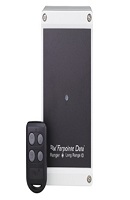
If you are an integrator that appreciates the growing importance of Electronic Access Control (EAC) to your vocation, a part of your learning curve needs to include understanding wireless access control. That’s because the majority of all EAC systems being installed today — new or retrofit — are employing wireless for a very simple reason. These solutions let you and your customer enjoy a different benefit set when compared to more traditional hard-wired systems and often without the cost.
With no holes to drill, trenches to dig, wire to pull and minimal installation disturbance to the customer, the implementation of a wireless system may be faster and less expensive than a wired system. In many retrofit situations such as in older buildings, there may be no alternative. Plus, wireless systems work with the great majority of access control product brands.
A wireless system can really pay off for both the integrator and the customer. Instead of spending money on labor, which is normally contracted out, your customer will be able to buy more product with the same budget. Or, if you are in a bid sale, the wireless solution will have a much lower cost than a wired alternative. The bottom line is that wireless systems use less hardware and install up to ten times faster.
Another positive for the integrator that sells wireless solutions is that these systems enable the protection of openings beyond doors. You now can provide easy-to- implement access control for exit devices, gates and even elevators, all controlled by your choice of access control management system. With such systems, your customer can continue to use their present contactless cards for all access points, whether entering the parking lot, the building or the elevator to the seventh floor at a price much smaller than wired systems and even less than using offline, standalone systems.
Contrary to what many will tell you, no line of sight is needed. Wireless RF signals can penetrate cinder block walls, plasterboard walls, brick walls and many other non-metallic materials for simplified system designs and implementations. They are secure, with many making use of AES encryption. They work on wood and metal doors, both exterior and interior, as well as glass, monitored and scheduled doors, gates and elevators.
Wireless systems typically operate up to 200 feet between the door and the panel interface module (PIM) for indoor applications. For outdoor applications, like vehicle and pedestrian gate access, wireless links can often bridge up to 1,000 feet, eliminating costly trenching. Thus, wireless systems are ideal for garages, parking lots, across city streets and other outdoor areas that the customer may want to access using the same contactless credentials they employ at the front door. They are especially cost-effective for controlling gates around a facility. Additionally, they are the natural choice for temporary system installations.
Don’t forget to add the elevators to your bid list. They are a perfect candidate for extending the access control system. Traveling cables are routinely included when installed, yet they may be unable to reliably transport access control data from the cab to the elevator controller. Elevator shafts provide an unforgiving environment for electrical signals, often being the culprit that creates data corrupting noise which pollutes card reader data lines. This can lead to the system providing inconsistent performance, which may actually worsen over time as cable shielding decays due to continual movement.
With a wireless solution, you can eliminate the need for data lines in elevators. In fact, they can thrive in this challenging installation environment and provide consistent, reliable data transport that does not wear out. As a result, you may have the opportunity to save your customers thousands of dollars per elevator.
To clarify the role of wireless in access control, some people classify the use of contactless credentials as wireless —125 kHz, 13.56 MHz, 433 MHz, NFC and Bluetooth.
125 kHz – This is what the primary contactless credential used in access control systems — the proximity card — uses to transmit information from the card to the reader.
13.56 MHz – In the last decade, proximity cards have been augmented by the smart card, which uses 13.56 MHz technology. This provides two-way communication, sending information to the reader and, then, the reader sending information back to update the card.
433 MHz – There has been great interest in long-range reading, which uses 433 MHz technology. In fact, at the recent ISC East conference, easily one out of three visitors to the Farpointe booth specifically wanted to discuss long-range identification technology. It can be installed as a complement to either a proximity or smart card system.
NFC – Near Field Communications is the short-range technology used to let people use their smartphones just like a contactless card in conjunction with the reader. To enter, a user opens the access control app and taps their phone to the smart reader on the wall in the same way that they would present their contactless ID badge.
Bluetooth – This technology is often considered a wireless competitor to NFC technology, as it is also commonly found on smartphones. In operation, the user will typically open an app, select the door to open and then push the ‘unlock’ button. Bluetooth supports ranges up to 300 feet, making it a long-range option.
It is oftentimes a big jump for your customer as well as you when you first undertake moving from a mechanical locking system to a networked EAC wireless solution. Remember the KISS acronym — Keep It Simple, Stupid. You do not need to undertake the complete upgrade all at once. Space it out, getting more and more comfortable with each installation. Your communication module manufacturer can be of great help in guiding you.











